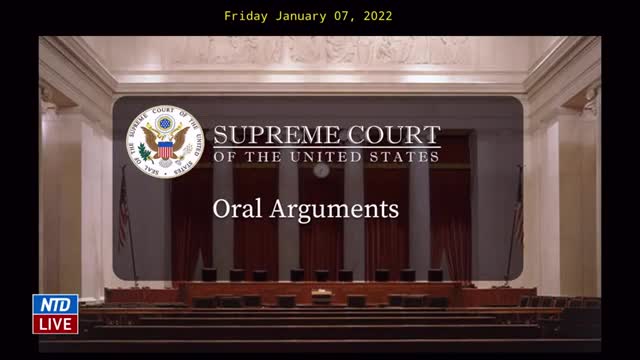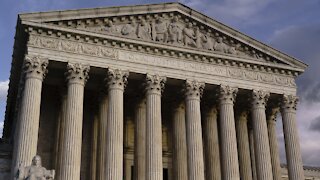Premium Only Content

Supreme Court Hearing on Vaccine Mandates, OSHA, Emergency Use ..
Vaccine Mandate
Supreme Court Hearing on Vaccine Mandates, OSHA, Emergency Use ..
Biden vaccine policies face Supreme Court
With over 100,000 Americans hospitalized for COVID-19 as a result of the highly contagious Omicron variant, the Supreme Court will hear oral argument Friday in two sets of challenges to the Biden administration’s authority to take action to combat the pandemic. In the first case, National Federation of Independent Business v. Department of Labor, the justices will consider the Biden administration’s attempt to impose a vaccine-or-test mandate for workers at large employers. In the second case, Biden v. Missouri, they will consider a vaccine mandate for health care workers at facilities that receive federal funding.
The vaccine disputes came to the court last month on an emergency basis, a procedural posture in which the justices might have generally been inclined to dispose of them with a brief order without hearing argument. But the justices instead opted to fast-track the cases for oral argument on Jan. 7 on whether the mandates can remain in place while challenges to their legality continue in the lower courts. It was the third time this term that the justices moved highly charged and time-sensitive issues off the so-called shadow docket and onto the merits docket for full briefing and argument. (The earlier cases in which the court took that unusual step involved Texas’ restrictive anti-abortion law and a religious-liberty claim from a man on death row.)
The OSHA mandate
Issued by the Occupational Safety and Health Administration on Nov. 5, the vaccine-or-test mandate requires all employers with 100 or more employees – approximately two-thirds of the private sector – to mandate that those employees either be fully vaccinated against COVID-19 or be tested weekly and wear masks at work. Several challenges were filed around the country and eventually consolidated in the U.S. Court of Appeals for the 6th Circuit, which reinstated the mandate after another court had put it on hold. The challengers quickly came to the Supreme Court, asking the justices to freeze the 6th Circuit’s ruling. In a brief order on Dec. 22, the justices set two of those requests for oral argument on Jan. 7 but left the 6th Circuit’s ruling reviving the mandate in place.
Defending the mandate, the Biden administration stresses that the “unprecedented” COVID-19 pandemic has already “infected more than 50 million and killed more than 800,000 people in the United States alone.” In imposing the vaccine-or-test mandate, Solicitor General Elizabeth Prelogar emphasizes, OSHA simply exercised the power that Congress gave it under the Occupational Safety and Health Act of 1970, which directs OSHA to issue emergency rules when it determines that a rule is “necessary” to protect employees from a “grave danger” from exposure to “physically harmful” “agents” or “new hazards.” Emergency rules can go into effect immediately, without the notice-and-comment procedures normally required for agency rulemaking. In this case, Prelogar continues, OSHA concluded that the COVID-19 virus is “both a physically harmful agent” and a “new hazard,” and that unvaccinated employees who are exposed to the virus at work face a “grave danger.” Therefore, she reasons, the mandate is necessary to protect those employees from the possibility of contracting COVID-19 while they are at work – saving over 6,500 lives and preventing over a quarter-million employees from being hospitalized over a six-month period.
One set of challengers is a group of 27 states, led by Ohio, who argue that the mandate is “nothing more than a pretext for increasing the number of vaccinated Americans.” OSHA, the states stress, can only regulate dangers that workers actually face in the workplace because of their jobs, not all hazards – like COVID-19 – that workers might encounter at some point while going about their days. And in this case, the states write, although there is no doubt that COVID-19 is dangerous, it does not present the kind of “grave” danger to workers required by the OSH Act because the risks of death for unvaccinated workers who become infected with the virus “are not significantly greater” than the risk for vaccinated workers. The mandate also does not comply with the requirements of the act, the states contend, because although OSHA explained that the mandate would be “beneficial to protect workers and society as a whole,” it never found that it is “necessary” to protect workers.
The second set of challengers is a group of trade associations led by the National Federation of Independent Business, which spearheaded the unsuccessful 2012 challenge to the Affordable Care Act’s individual insurance mandate. They tell the justices that if the vaccine-or-test mandate is allowed to remain in place, it will “inflict irreparable harm upon hundreds of thousands of businesses” across the country. Businesses, the challengers explain, will have to choose between paying for testing for employees who decline to be vaccinated, and then passing those costs on to consumers, or requiring employees to absorb the costs, which could lead them to quit. “The resulting labor upheaval will devastate already fragile supply chains and labor markets,” they conclude.
The trade associations contend that the mandate is also barred by the “major questions” doctrine – the idea that Congress must speak clearly if it intends to delegate a “vast expansion” of an agency’s regulatory power on such an important issue. There is no such clear statement here, the groups suggest, as evidenced by the fact that OSHA has never before tried to use its emergency powers to regulate an airborne virus. Even when OSHA has tried to use its emergency powers more narrowly, the groups observe, courts have still been skeptical. OSHA has previously issued only 10 emergency standards; of the six that were challenged in court, courts upheld only one. Although OSHA’s powers to address emergencies apply only to workplace dangers that employees face, the groups underscore, the vaccine-or-test mandate is “an unprecedented, one-size-fits-all mandate for every business” in the US. “It is implausible, in light of the OSH Act’s text and structure and OSHA’s own practice,” the groups suggest, “that Congress would delegate to OSHA the emergency power to address global pandemics that affect everyone, everywhere, all of the time,” particularly when OSHA does not have any expertise in dealing with a global pandemic.
The Biden administration pushes back, telling the justices that Congress made clear in the OSH Act that it wanted to guarantee “safe and healthful working conditions” for all workers, which “might require substantial regulations that apply nationwide and carry significant compliance costs.” The key question, the administration tells the justices, is whether the requirements of the OSH Act have been met, and they have been: OSHA has determined that the COVID-19 virus is “a physically harmful agent, exposure to it in the workplace presents a grave danger to employees, and the [mandate] is necessary to protect employees from that danger.” Moreover, the administration adds, Congress not only envisioned that OSHA might require immunizations to protect workers, but in the American Rescue Plan of 2021, it also instructed OSHA to use its authority to protect workers from COVID-19 – and even appropriated funds for it to do so.
The Biden administration dismisses the challengers’ argument that workers will quit if they have to get vaccinated as purely speculative. It notes that employers can choose the mask-and-test option rather than require their employees to get vaccinated, and it adds that such speculation is in any event inconsistent with the experience of private employers, like United Airlines, that have imposed their own mandates. By contrast, the government emphasizes, because the harms to the public from blocking enforcement of the mandate “would be enormous,” the court should at the very least leave the mask-or-test requirement in place even if it puts the vaccine requirement on hold.
The mandate for health care workers
Also in November, the Department of Health and Human Services issued a rule that requires all health care workers at facilities that participate in the Medicare and Medicaid programs – over 10 million workers in total – to be fully vaccinated against COVID-19 unless they are eligible for a medical or religious exemption.
Several challenges to the rule followed. A federal district court in Missouri put the rule on hold for 10 states, while a federal district court in Louisiana did the same for 14 other states. That prompted the Biden administration to come to the Supreme Court in December, asking the justices to put the district courts’ rulings on hold and allow the rule to take effect nationwide while litigation continues.
The issues and arguments in the dispute over the Medicare/Medicaid vaccine mandate are in many ways similar to those in the employer vaccine-or-test mandate. The administration contends that Congress gave HHS broad authority, including the power to require health care facilities that want to participate in Medicare and Medicaid to comply with conditions that the secretary concludes are “necessary in the interest of the health and safety” of their patients. Using that power, the administration writes, HHS has long required health care facilities to establish programs to prevent and control infectious diseases.
In this case, the administration continues, HHS saw that COVID-19 vaccination rates at health care facilities were low – under 70% at hospitals and long-term care facilities in September 2021. It is, the administration contends, “hard to imagine a more paradigmatic health and safety condition than a requirement that workers at hospitals, nursing homes and other medical facilities take the step that most effectively prevents transmission of a deadly virus to vulnerable patients.” Moreover, the administration adds, it is important to act immediately in light of the “anticipated winter surge in infections” and the prospect that the mandate “will save hundreds or even thousands of lives each month.”
The states challenging the mandate call the vaccine requirement “sweeping and unprecedented,” and they say that it “threatens to create a crisis in healthcare facilities in rural America,” which already suffers from a shortage of health care workers. For example, they write, one hospital in rural Nebraska could lose one-third of its staff, while a nursing home in rural Missouri could also lose nearly a third of its staff – creating the possibility that both might have to shut down.
The states argue that the provision on which the government relies is a “housekeeping statute” that does not give HHS the broad power that the government claims. Instead, they suggest, it merely gives HHS the power to “make practical rules that keep Medicaid and Medicare operating smoothly and economically, such as rules that update billing procedures or clarify discretionary grant-allocation criteria.” If the federal government’s interpretation were correct, they say, HHS could impose all kinds of mandates – requiring health care workers, for example, to meet body-mass-index standards, participate in exercise programs, or eat broccoli – as part of an effort to ensure that they can provide the best care.
The states also challenge HHS’ decision to impose the mandate without first providing notice of its intent to issue the mandate and allowing an opportunity for the public to comment on the draft rule. Two months passed between the administration’s announcement of its intention to issue the mandate and the actual mandate itself, the states note, which would have given it plenty of time to receive comments.
Finally, like the challengers in the employer vaccine-or-test case, the states contend that the “major questions” doctrine applies, because the power that HHS is asserting is so expansive that the court should not accept the government’s interpretation without a clear statement from Congress.
The Biden administration counters that Congress did provide the kind of clear statement needed to authorize HHS to issue a vaccine mandate. Specifically, although it could have limited HHS’ discretion to act, as it has done with other agencies, it did not. And it concedes that some health care workers might opt to quit rather than be vaccinated, but it points out that resignation rates in hospitals that have imposed their own vaccine mandates are low, and it suggests that, without a mandate, health care facilities would face disruptions when workers were forced to stay home because of illness or exposure to COVID-19.
-
 2:51
2:51
Newsy
2 years agoSupreme Court Weighs President Biden's Vaccine Mandates
7.34K82 -
 6:19
6:19
Dinesh D'Souza
3 years agoHow Might the Supreme Court Interpret the Constitutionality of Vaccine Mandates?
4.83K41 -
 2:22
2:22
KERO
2 years agoFederal vaccine mandate debate reaches Supreme Court
2521 -
 2:12:46
2:12:46
Price of Reason
1 day agoAmber Heard BACKS Blake Lively Lawsuit Against Justin Baldoni! Is Disney CEO Bob Iger in TROUBLE?
77.3K24 -
 1:01:17
1:01:17
The StoneZONE with Roger Stone
23 hours agoChristmas Edition: Why the Panama Canal is Part of the America First Agenda | The StoneZONE
146K52 -
 18:12:15
18:12:15
LFA TV
1 day agoLFA TV CHRISTMAS EVE REPLAY
156K19 -
 13:32
13:32
Scammer Payback
1 day agoChanging the Scammer's Desktop Background to his Location
23.2K6 -
 4:21
4:21
BIG NEM
1 day agoNikola Tesla's Secret to Cultivating Creativity & Genius
17.9K1 -
 15:03
15:03
The Anthony Rogers Show
2 days agoAnthony Rogers - Live at Cusumano's Pizza (Upstairs)
14.2K1 -
 4:33:48
4:33:48
tacetmort3m
1 day ago🔴 LIVE - THE ZONE KEEPS PULLING ME BACK - STALKER 2 - PART 15
77.3K13